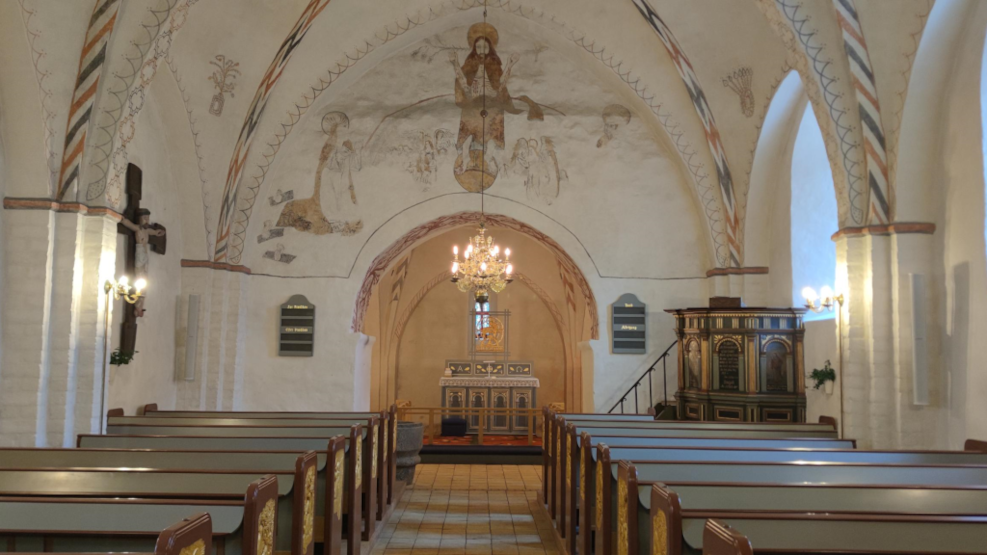
Sdr. Vissing Church
This Romanesque church from the late 12th century is home to two fascinating, historical runestones from the Viking Age. In fact, one of these, Queen Tove's runestone, is among the most significant runestones in Danish history. Additionally, the beautiful church interior is adorned with captivating, decorative frescoes.
A historical church in a historical area
Sdr. Vissing is located in the southern part of the Lakelands, near the Gudenå River and large lakes such as Salten Langsø and Mossø. In the fertile and hilly farmlands surrounding the town, you find many burial mounds, indicating that this area has been inhabited for a very long time.
The town's church dates from around 1175, making it part of the large number of Romanesque churches built during this period, when wooden churches of the Viking Age were replaced by new Christian stone churches. The church is fairly large for a village church of this time, which also indicates that the town had a certain status during this period.
Sdr. Vissing is placed in an area where, historically, there were many monasteries – and in the Middle Ages, the church belonged to the neighbouring Vissing Monastery. When Vissing Monastery was demolished in 1420, the church was placed under the Bishop of Aarhus, much to the displeasure of Voer Monastery, who claimed the church for themselves. This led to major conflict, involving attention from both the king and the pope.
During the Reformation, the king took control of all Danish churches, and the church was consequently placed under Skanderborg Castle. Later, the church was traded among a series of wealthy private owners until it finally became self-owned in 1910.
Sdr. Vissing Church
Like many other churches of its time, Sønder Vissing Church consists of an original Romanesque nave and chancel, while the Gothic tower and porch were not added until the late 1400s.
The church stands whitewashed and beautiful, surrounded by a lovely churchyard. The original parts of the church from the 12th century include the south and north entrances, with the northern entrance being surrounded by pillars, as well as the baptismal font.
The church interior itself is warm and bright. The eye is quickly drawn to the prominent frescoes from the late 1400s. As was often the case in the Renaissance, the frescoes had a decorative function, following the lines of the church. Visually, this creates a gorgeous church space, where the paintings stand in excellent contrast to the whitewashed walls. Biblical motifs are also depicted, including Saint George slaying a dragon.
The two runestones
However, the most famous artifacts of the church are undoubtedly the two runestones, located in the chancel and the porch, respectively. By all accounts, the stones have been standing atop the burial mounds on which the church is now placed. The stones date back to the period of 950-1000 of the Viking Age, with text from the younger runic alphabet.
The first runestone holds quite an interesting inscription that has given important knowledge to Danish History. The text on the stone reads accordingly: ”Tove, Mistivis datter, Harald den Godes, Gorms søns kone, lod gøre kuml efter sin mor”.
The text suggests that in the 900s, Harald Bluetooth married a Wendish princess named Tove, whose father ruled the Obotrites of that area, known today as Oldenburg. Our historical knowledge of the relationship between Tove and Harald Bluetooth is based solely on the inscription from the stone in Sønder Vissing. Furthermore, the writing on the first stone not only suggests that Harald Bluetooth was quite active in the area, but also indicates that the area surrounding Sdr. Vissing had an important role to play in expanding Christianity in Denmark. This could also explain the many monasteries historically found in the area.
On the second stone, it reads, "Toke gjorde disse kumler efter sin fader Abe (Ebbe), en klog mand”. The name Toke was the most popular male name at that time and appears on many Danish runestones. In Gylling Church, there is also a runestone set up by a Toke – but it is not the same person.
This runestone is also a cup-stone, meaning that the stone was used as a cult stone more than 3,000 years ago. The cup-shaped holes are highly visible in the stone.
More historical attractions
Kystlandet has many exciting historical attractions on offer, from ancient history to industrial history. From museums to buildings to natural sights. On this page, you find inspiration for historically interesting experiences near Horsens, Odder, and Juelsminde.